Position Paper: Meatification of Diets
VerifiedAdded on 2023/04/21
|15
|3859
|195
AI Summary
This position paper discusses the concept of 'Meatification' of diets and argues in favor of meat biofabrication as an innovative and ecologically beneficial alternative to traditional meat production techniques.
Contribute Materials
Your contribution can guide someone’s learning journey. Share your
documents today.
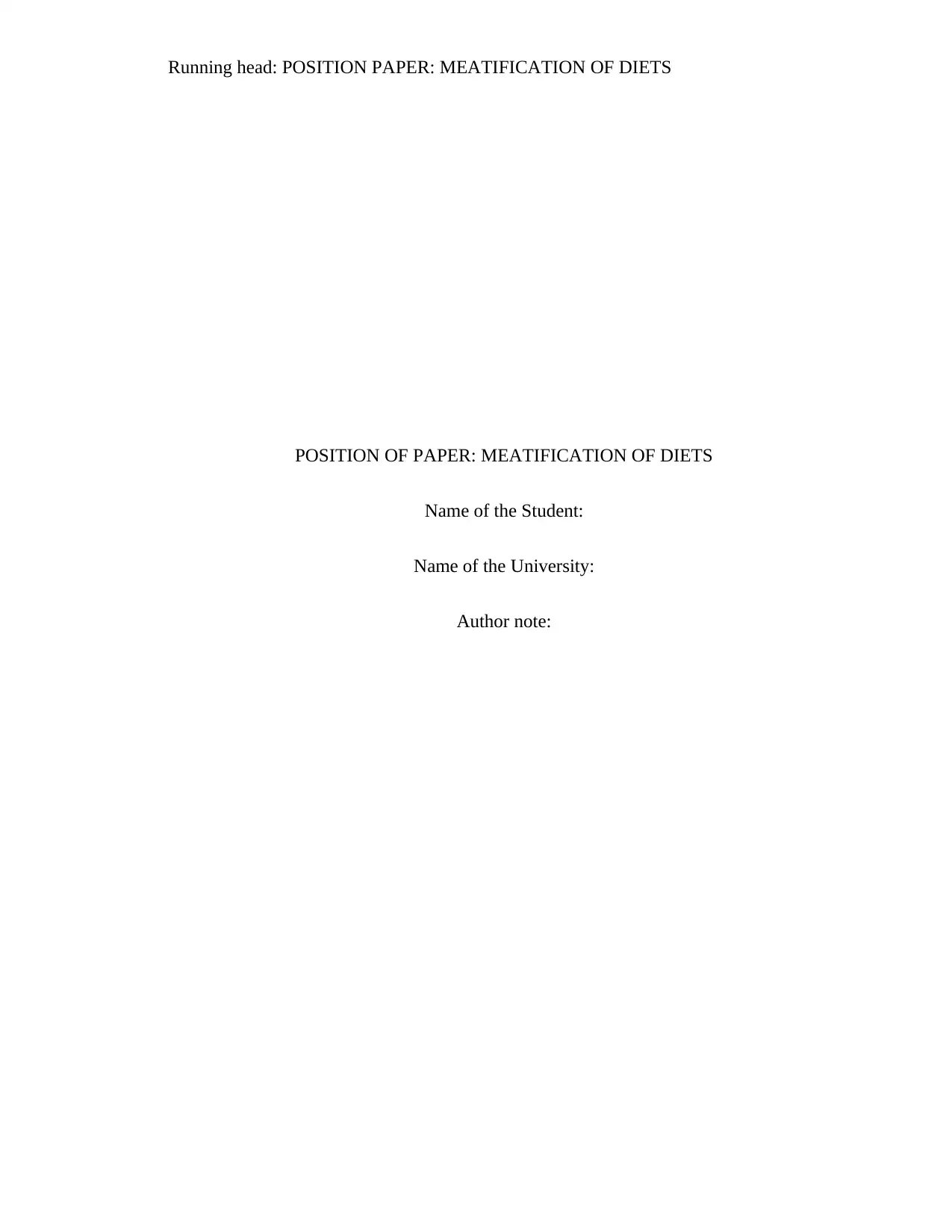
Running head: POSITION PAPER: MEATIFICATION OF DIETS
POSITION OF PAPER: MEATIFICATION OF DIETS
Name of the Student:
Name of the University:
Author note:
POSITION OF PAPER: MEATIFICATION OF DIETS
Name of the Student:
Name of the University:
Author note:
Secure Best Marks with AI Grader
Need help grading? Try our AI Grader for instant feedback on your assignments.

1POSITION PAPER: MEATIFICATION OF DIETS
Introduction
The concept of ‘Meatification’ of diets, as postulated by Weis (2015), implies the
increasing infiltration and consumption of meat and meat products in the daily diets of
individuals. The increasing consumption of meat has been associated with a number of ethical
and humanitarian concerns, environmental implications, increased pathogenic disease
transmission and physiological complications (Apostolidis & McLeay, 2016). Advancements in
science and technology have witnessed emergence of innovative meatless solutions. ‘Meat
Biofabrication’ or the proliferation of meat tissues in vitro has been advocated as an
advantageous alterative to actual meat consumption devoid of the associated environmental,
microbial, physiological and ethical concerns (Bhat, Kumar & Bhat, 2017). Hence the following
paper will choose to argue in favor of the proposed thesis statement:
Thesis Statement
Meat Biofabrication is an innovated meat production and ecologically beneficial
alternative agricultural technique for the manufacturing of microbiologically safe, nutritionally
adequate and ethical sound meat products.
Discussion
Supporting Arguments
Ethical Production
As noted by Arshad et al., (2017), one of the primary arguments in favor of meat
biofabrication is its ability to produce meat ‘without victims’. Tradition meat production and
Introduction
The concept of ‘Meatification’ of diets, as postulated by Weis (2015), implies the
increasing infiltration and consumption of meat and meat products in the daily diets of
individuals. The increasing consumption of meat has been associated with a number of ethical
and humanitarian concerns, environmental implications, increased pathogenic disease
transmission and physiological complications (Apostolidis & McLeay, 2016). Advancements in
science and technology have witnessed emergence of innovative meatless solutions. ‘Meat
Biofabrication’ or the proliferation of meat tissues in vitro has been advocated as an
advantageous alterative to actual meat consumption devoid of the associated environmental,
microbial, physiological and ethical concerns (Bhat, Kumar & Bhat, 2017). Hence the following
paper will choose to argue in favor of the proposed thesis statement:
Thesis Statement
Meat Biofabrication is an innovated meat production and ecologically beneficial
alternative agricultural technique for the manufacturing of microbiologically safe, nutritionally
adequate and ethical sound meat products.
Discussion
Supporting Arguments
Ethical Production
As noted by Arshad et al., (2017), one of the primary arguments in favor of meat
biofabrication is its ability to produce meat ‘without victims’. Tradition meat production and
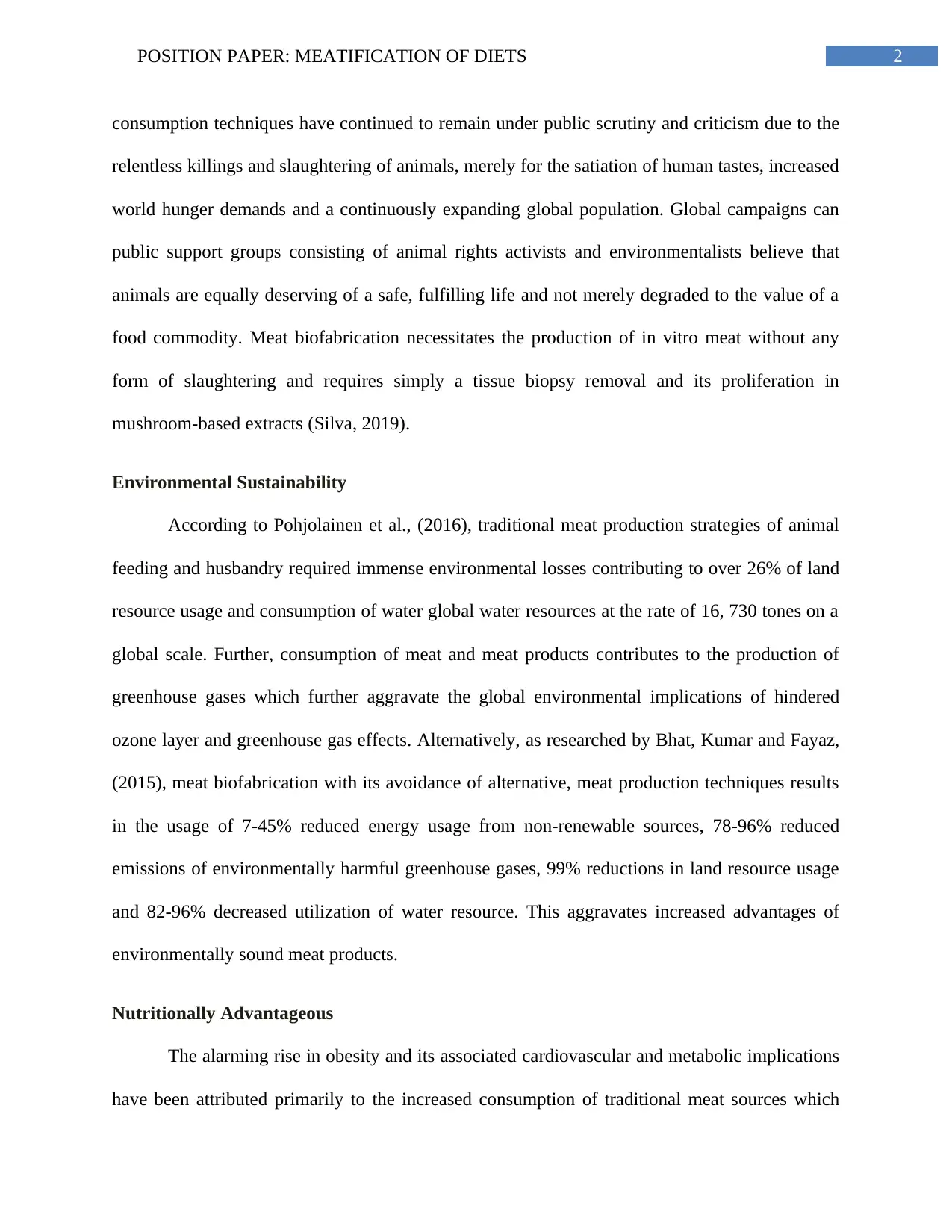
2POSITION PAPER: MEATIFICATION OF DIETS
consumption techniques have continued to remain under public scrutiny and criticism due to the
relentless killings and slaughtering of animals, merely for the satiation of human tastes, increased
world hunger demands and a continuously expanding global population. Global campaigns can
public support groups consisting of animal rights activists and environmentalists believe that
animals are equally deserving of a safe, fulfilling life and not merely degraded to the value of a
food commodity. Meat biofabrication necessitates the production of in vitro meat without any
form of slaughtering and requires simply a tissue biopsy removal and its proliferation in
mushroom-based extracts (Silva, 2019).
Environmental Sustainability
According to Pohjolainen et al., (2016), traditional meat production strategies of animal
feeding and husbandry required immense environmental losses contributing to over 26% of land
resource usage and consumption of water global water resources at the rate of 16, 730 tones on a
global scale. Further, consumption of meat and meat products contributes to the production of
greenhouse gases which further aggravate the global environmental implications of hindered
ozone layer and greenhouse gas effects. Alternatively, as researched by Bhat, Kumar and Fayaz,
(2015), meat biofabrication with its avoidance of alternative, meat production techniques results
in the usage of 7-45% reduced energy usage from non-renewable sources, 78-96% reduced
emissions of environmentally harmful greenhouse gases, 99% reductions in land resource usage
and 82-96% decreased utilization of water resource. This aggravates increased advantages of
environmentally sound meat products.
Nutritionally Advantageous
The alarming rise in obesity and its associated cardiovascular and metabolic implications
have been attributed primarily to the increased consumption of traditional meat sources which
consumption techniques have continued to remain under public scrutiny and criticism due to the
relentless killings and slaughtering of animals, merely for the satiation of human tastes, increased
world hunger demands and a continuously expanding global population. Global campaigns can
public support groups consisting of animal rights activists and environmentalists believe that
animals are equally deserving of a safe, fulfilling life and not merely degraded to the value of a
food commodity. Meat biofabrication necessitates the production of in vitro meat without any
form of slaughtering and requires simply a tissue biopsy removal and its proliferation in
mushroom-based extracts (Silva, 2019).
Environmental Sustainability
According to Pohjolainen et al., (2016), traditional meat production strategies of animal
feeding and husbandry required immense environmental losses contributing to over 26% of land
resource usage and consumption of water global water resources at the rate of 16, 730 tones on a
global scale. Further, consumption of meat and meat products contributes to the production of
greenhouse gases which further aggravate the global environmental implications of hindered
ozone layer and greenhouse gas effects. Alternatively, as researched by Bhat, Kumar and Fayaz,
(2015), meat biofabrication with its avoidance of alternative, meat production techniques results
in the usage of 7-45% reduced energy usage from non-renewable sources, 78-96% reduced
emissions of environmentally harmful greenhouse gases, 99% reductions in land resource usage
and 82-96% decreased utilization of water resource. This aggravates increased advantages of
environmentally sound meat products.
Nutritionally Advantageous
The alarming rise in obesity and its associated cardiovascular and metabolic implications
have been attributed primarily to the increased consumption of traditional meat sources which
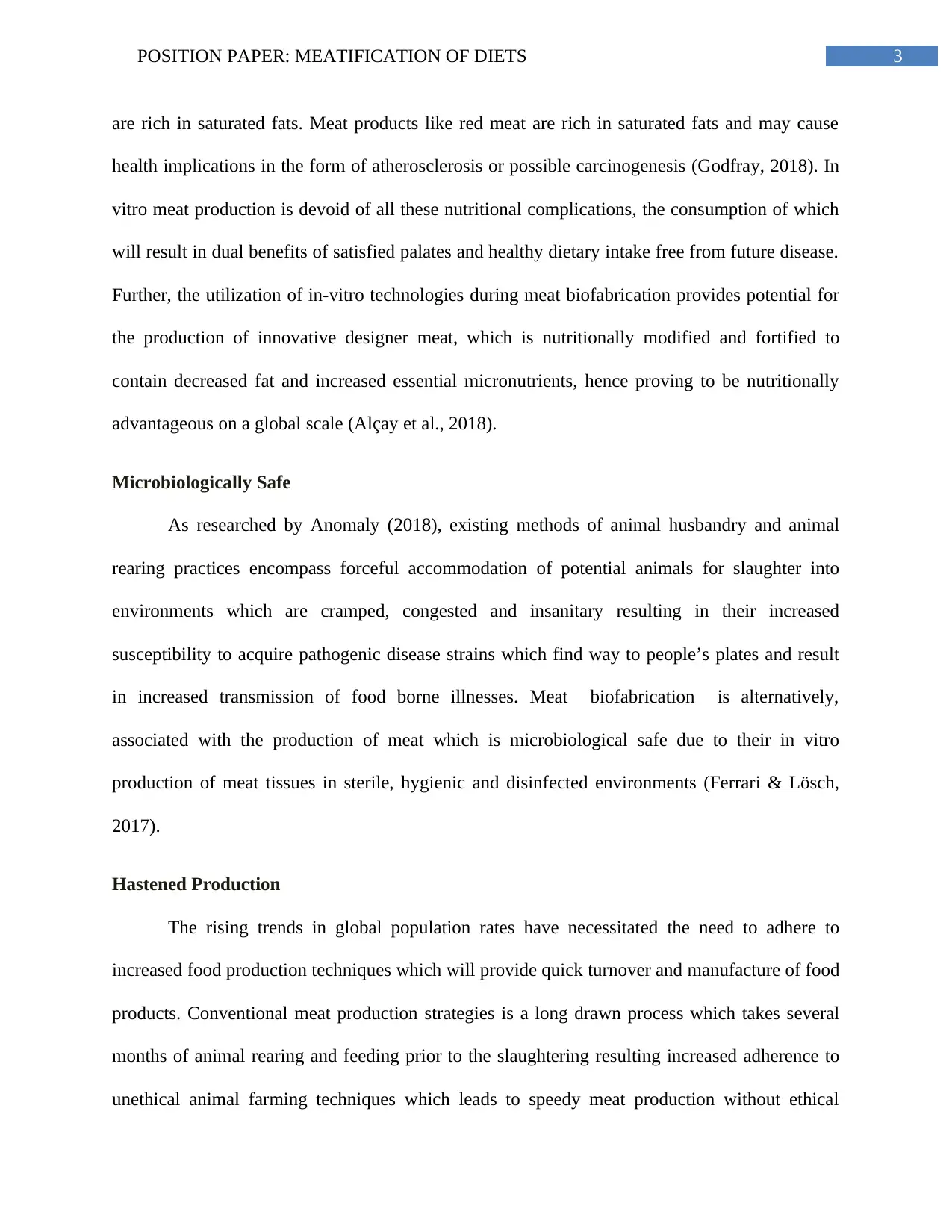
3POSITION PAPER: MEATIFICATION OF DIETS
are rich in saturated fats. Meat products like red meat are rich in saturated fats and may cause
health implications in the form of atherosclerosis or possible carcinogenesis (Godfray, 2018). In
vitro meat production is devoid of all these nutritional complications, the consumption of which
will result in dual benefits of satisfied palates and healthy dietary intake free from future disease.
Further, the utilization of in-vitro technologies during meat biofabrication provides potential for
the production of innovative designer meat, which is nutritionally modified and fortified to
contain decreased fat and increased essential micronutrients, hence proving to be nutritionally
advantageous on a global scale (Alçay et al., 2018).
Microbiologically Safe
As researched by Anomaly (2018), existing methods of animal husbandry and animal
rearing practices encompass forceful accommodation of potential animals for slaughter into
environments which are cramped, congested and insanitary resulting in their increased
susceptibility to acquire pathogenic disease strains which find way to people’s plates and result
in increased transmission of food borne illnesses. Meat biofabrication is alternatively,
associated with the production of meat which is microbiological safe due to their in vitro
production of meat tissues in sterile, hygienic and disinfected environments (Ferrari & Lösch,
2017).
Hastened Production
The rising trends in global population rates have necessitated the need to adhere to
increased food production techniques which will provide quick turnover and manufacture of food
products. Conventional meat production strategies is a long drawn process which takes several
months of animal rearing and feeding prior to the slaughtering resulting increased adherence to
unethical animal farming techniques which leads to speedy meat production without ethical
are rich in saturated fats. Meat products like red meat are rich in saturated fats and may cause
health implications in the form of atherosclerosis or possible carcinogenesis (Godfray, 2018). In
vitro meat production is devoid of all these nutritional complications, the consumption of which
will result in dual benefits of satisfied palates and healthy dietary intake free from future disease.
Further, the utilization of in-vitro technologies during meat biofabrication provides potential for
the production of innovative designer meat, which is nutritionally modified and fortified to
contain decreased fat and increased essential micronutrients, hence proving to be nutritionally
advantageous on a global scale (Alçay et al., 2018).
Microbiologically Safe
As researched by Anomaly (2018), existing methods of animal husbandry and animal
rearing practices encompass forceful accommodation of potential animals for slaughter into
environments which are cramped, congested and insanitary resulting in their increased
susceptibility to acquire pathogenic disease strains which find way to people’s plates and result
in increased transmission of food borne illnesses. Meat biofabrication is alternatively,
associated with the production of meat which is microbiological safe due to their in vitro
production of meat tissues in sterile, hygienic and disinfected environments (Ferrari & Lösch,
2017).
Hastened Production
The rising trends in global population rates have necessitated the need to adhere to
increased food production techniques which will provide quick turnover and manufacture of food
products. Conventional meat production strategies is a long drawn process which takes several
months of animal rearing and feeding prior to the slaughtering resulting increased adherence to
unethical animal farming techniques which leads to speedy meat production without ethical
Secure Best Marks with AI Grader
Need help grading? Try our AI Grader for instant feedback on your assignments.
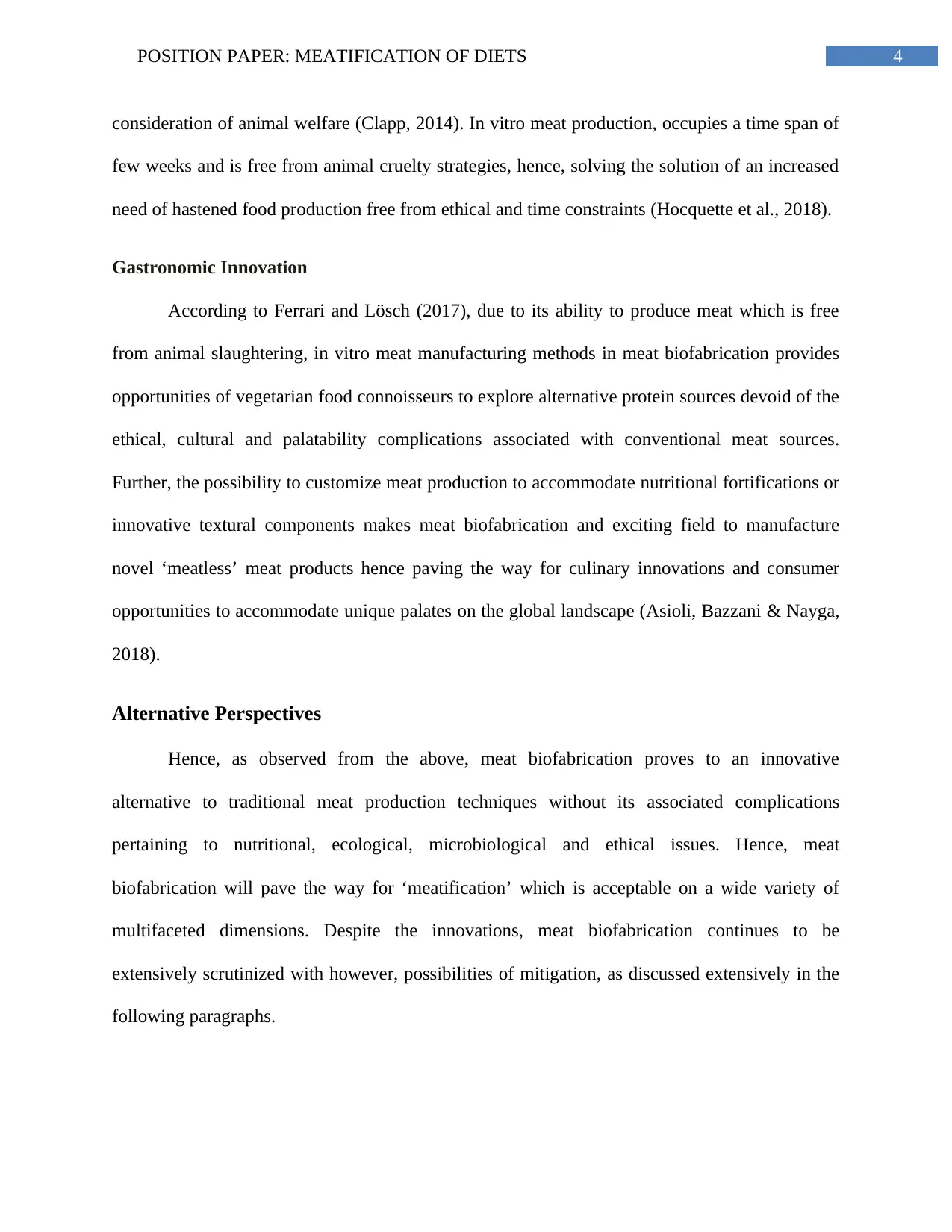
4POSITION PAPER: MEATIFICATION OF DIETS
consideration of animal welfare (Clapp, 2014). In vitro meat production, occupies a time span of
few weeks and is free from animal cruelty strategies, hence, solving the solution of an increased
need of hastened food production free from ethical and time constraints (Hocquette et al., 2018).
Gastronomic Innovation
According to Ferrari and Lösch (2017), due to its ability to produce meat which is free
from animal slaughtering, in vitro meat manufacturing methods in meat biofabrication provides
opportunities of vegetarian food connoisseurs to explore alternative protein sources devoid of the
ethical, cultural and palatability complications associated with conventional meat sources.
Further, the possibility to customize meat production to accommodate nutritional fortifications or
innovative textural components makes meat biofabrication and exciting field to manufacture
novel ‘meatless’ meat products hence paving the way for culinary innovations and consumer
opportunities to accommodate unique palates on the global landscape (Asioli, Bazzani & Nayga,
2018).
Alternative Perspectives
Hence, as observed from the above, meat biofabrication proves to an innovative
alternative to traditional meat production techniques without its associated complications
pertaining to nutritional, ecological, microbiological and ethical issues. Hence, meat
biofabrication will pave the way for ‘meatification’ which is acceptable on a wide variety of
multifaceted dimensions. Despite the innovations, meat biofabrication continues to be
extensively scrutinized with however, possibilities of mitigation, as discussed extensively in the
following paragraphs.
consideration of animal welfare (Clapp, 2014). In vitro meat production, occupies a time span of
few weeks and is free from animal cruelty strategies, hence, solving the solution of an increased
need of hastened food production free from ethical and time constraints (Hocquette et al., 2018).
Gastronomic Innovation
According to Ferrari and Lösch (2017), due to its ability to produce meat which is free
from animal slaughtering, in vitro meat manufacturing methods in meat biofabrication provides
opportunities of vegetarian food connoisseurs to explore alternative protein sources devoid of the
ethical, cultural and palatability complications associated with conventional meat sources.
Further, the possibility to customize meat production to accommodate nutritional fortifications or
innovative textural components makes meat biofabrication and exciting field to manufacture
novel ‘meatless’ meat products hence paving the way for culinary innovations and consumer
opportunities to accommodate unique palates on the global landscape (Asioli, Bazzani & Nayga,
2018).
Alternative Perspectives
Hence, as observed from the above, meat biofabrication proves to an innovative
alternative to traditional meat production techniques without its associated complications
pertaining to nutritional, ecological, microbiological and ethical issues. Hence, meat
biofabrication will pave the way for ‘meatification’ which is acceptable on a wide variety of
multifaceted dimensions. Despite the innovations, meat biofabrication continues to be
extensively scrutinized with however, possibilities of mitigation, as discussed extensively in the
following paragraphs.
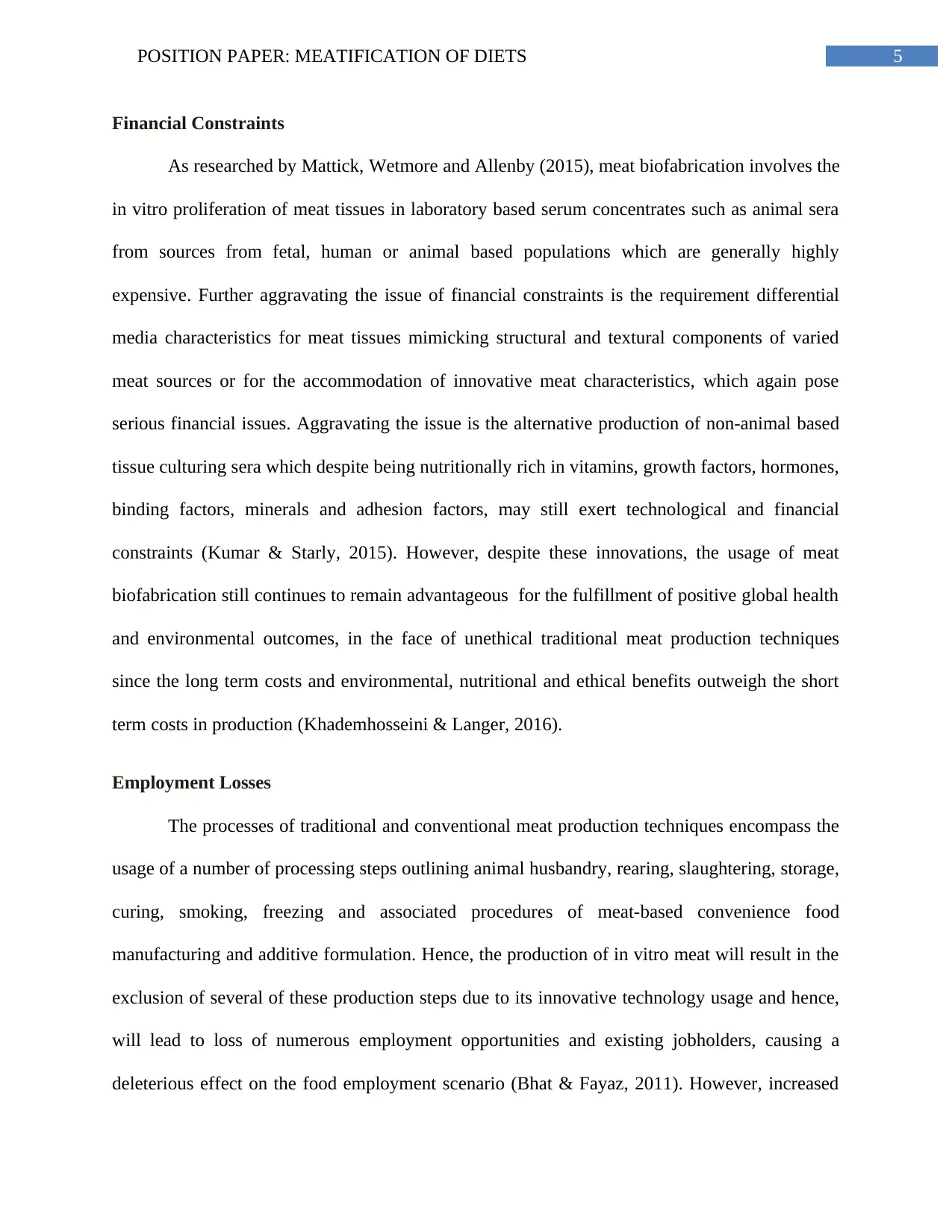
5POSITION PAPER: MEATIFICATION OF DIETS
Financial Constraints
As researched by Mattick, Wetmore and Allenby (2015), meat biofabrication involves the
in vitro proliferation of meat tissues in laboratory based serum concentrates such as animal sera
from sources from fetal, human or animal based populations which are generally highly
expensive. Further aggravating the issue of financial constraints is the requirement differential
media characteristics for meat tissues mimicking structural and textural components of varied
meat sources or for the accommodation of innovative meat characteristics, which again pose
serious financial issues. Aggravating the issue is the alternative production of non-animal based
tissue culturing sera which despite being nutritionally rich in vitamins, growth factors, hormones,
binding factors, minerals and adhesion factors, may still exert technological and financial
constraints (Kumar & Starly, 2015). However, despite these innovations, the usage of meat
biofabrication still continues to remain advantageous for the fulfillment of positive global health
and environmental outcomes, in the face of unethical traditional meat production techniques
since the long term costs and environmental, nutritional and ethical benefits outweigh the short
term costs in production (Khademhosseini & Langer, 2016).
Employment Losses
The processes of traditional and conventional meat production techniques encompass the
usage of a number of processing steps outlining animal husbandry, rearing, slaughtering, storage,
curing, smoking, freezing and associated procedures of meat-based convenience food
manufacturing and additive formulation. Hence, the production of in vitro meat will result in the
exclusion of several of these production steps due to its innovative technology usage and hence,
will lead to loss of numerous employment opportunities and existing jobholders, causing a
deleterious effect on the food employment scenario (Bhat & Fayaz, 2011). However, increased
Financial Constraints
As researched by Mattick, Wetmore and Allenby (2015), meat biofabrication involves the
in vitro proliferation of meat tissues in laboratory based serum concentrates such as animal sera
from sources from fetal, human or animal based populations which are generally highly
expensive. Further aggravating the issue of financial constraints is the requirement differential
media characteristics for meat tissues mimicking structural and textural components of varied
meat sources or for the accommodation of innovative meat characteristics, which again pose
serious financial issues. Aggravating the issue is the alternative production of non-animal based
tissue culturing sera which despite being nutritionally rich in vitamins, growth factors, hormones,
binding factors, minerals and adhesion factors, may still exert technological and financial
constraints (Kumar & Starly, 2015). However, despite these innovations, the usage of meat
biofabrication still continues to remain advantageous for the fulfillment of positive global health
and environmental outcomes, in the face of unethical traditional meat production techniques
since the long term costs and environmental, nutritional and ethical benefits outweigh the short
term costs in production (Khademhosseini & Langer, 2016).
Employment Losses
The processes of traditional and conventional meat production techniques encompass the
usage of a number of processing steps outlining animal husbandry, rearing, slaughtering, storage,
curing, smoking, freezing and associated procedures of meat-based convenience food
manufacturing and additive formulation. Hence, the production of in vitro meat will result in the
exclusion of several of these production steps due to its innovative technology usage and hence,
will lead to loss of numerous employment opportunities and existing jobholders, causing a
deleterious effect on the food employment scenario (Bhat & Fayaz, 2011). However, increased
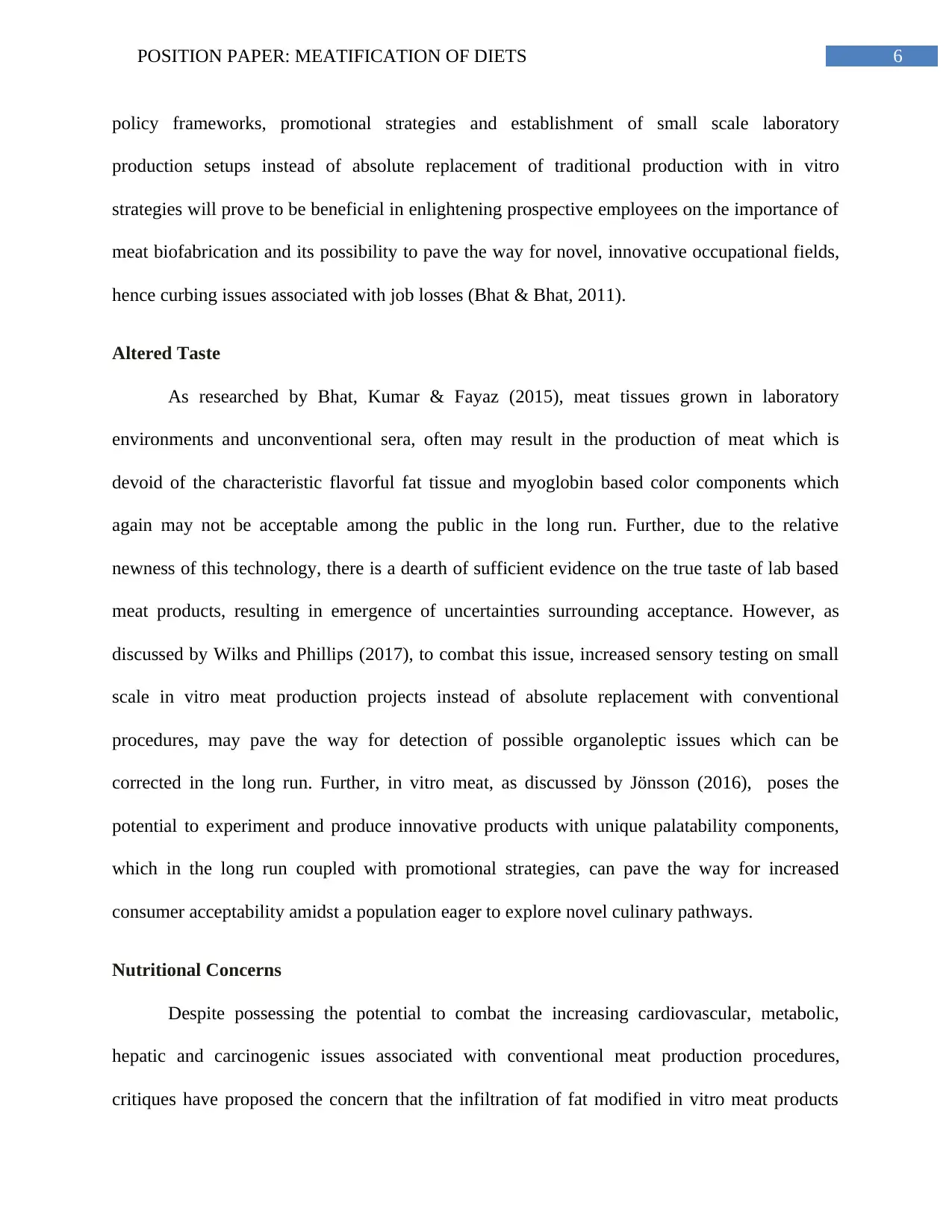
6POSITION PAPER: MEATIFICATION OF DIETS
policy frameworks, promotional strategies and establishment of small scale laboratory
production setups instead of absolute replacement of traditional production with in vitro
strategies will prove to be beneficial in enlightening prospective employees on the importance of
meat biofabrication and its possibility to pave the way for novel, innovative occupational fields,
hence curbing issues associated with job losses (Bhat & Bhat, 2011).
Altered Taste
As researched by Bhat, Kumar & Fayaz (2015), meat tissues grown in laboratory
environments and unconventional sera, often may result in the production of meat which is
devoid of the characteristic flavorful fat tissue and myoglobin based color components which
again may not be acceptable among the public in the long run. Further, due to the relative
newness of this technology, there is a dearth of sufficient evidence on the true taste of lab based
meat products, resulting in emergence of uncertainties surrounding acceptance. However, as
discussed by Wilks and Phillips (2017), to combat this issue, increased sensory testing on small
scale in vitro meat production projects instead of absolute replacement with conventional
procedures, may pave the way for detection of possible organoleptic issues which can be
corrected in the long run. Further, in vitro meat, as discussed by Jönsson (2016), poses the
potential to experiment and produce innovative products with unique palatability components,
which in the long run coupled with promotional strategies, can pave the way for increased
consumer acceptability amidst a population eager to explore novel culinary pathways.
Nutritional Concerns
Despite possessing the potential to combat the increasing cardiovascular, metabolic,
hepatic and carcinogenic issues associated with conventional meat production procedures,
critiques have proposed the concern that the infiltration of fat modified in vitro meat products
policy frameworks, promotional strategies and establishment of small scale laboratory
production setups instead of absolute replacement of traditional production with in vitro
strategies will prove to be beneficial in enlightening prospective employees on the importance of
meat biofabrication and its possibility to pave the way for novel, innovative occupational fields,
hence curbing issues associated with job losses (Bhat & Bhat, 2011).
Altered Taste
As researched by Bhat, Kumar & Fayaz (2015), meat tissues grown in laboratory
environments and unconventional sera, often may result in the production of meat which is
devoid of the characteristic flavorful fat tissue and myoglobin based color components which
again may not be acceptable among the public in the long run. Further, due to the relative
newness of this technology, there is a dearth of sufficient evidence on the true taste of lab based
meat products, resulting in emergence of uncertainties surrounding acceptance. However, as
discussed by Wilks and Phillips (2017), to combat this issue, increased sensory testing on small
scale in vitro meat production projects instead of absolute replacement with conventional
procedures, may pave the way for detection of possible organoleptic issues which can be
corrected in the long run. Further, in vitro meat, as discussed by Jönsson (2016), poses the
potential to experiment and produce innovative products with unique palatability components,
which in the long run coupled with promotional strategies, can pave the way for increased
consumer acceptability amidst a population eager to explore novel culinary pathways.
Nutritional Concerns
Despite possessing the potential to combat the increasing cardiovascular, metabolic,
hepatic and carcinogenic issues associated with conventional meat production procedures,
critiques have proposed the concern that the infiltration of fat modified in vitro meat products
Paraphrase This Document
Need a fresh take? Get an instant paraphrase of this document with our AI Paraphraser
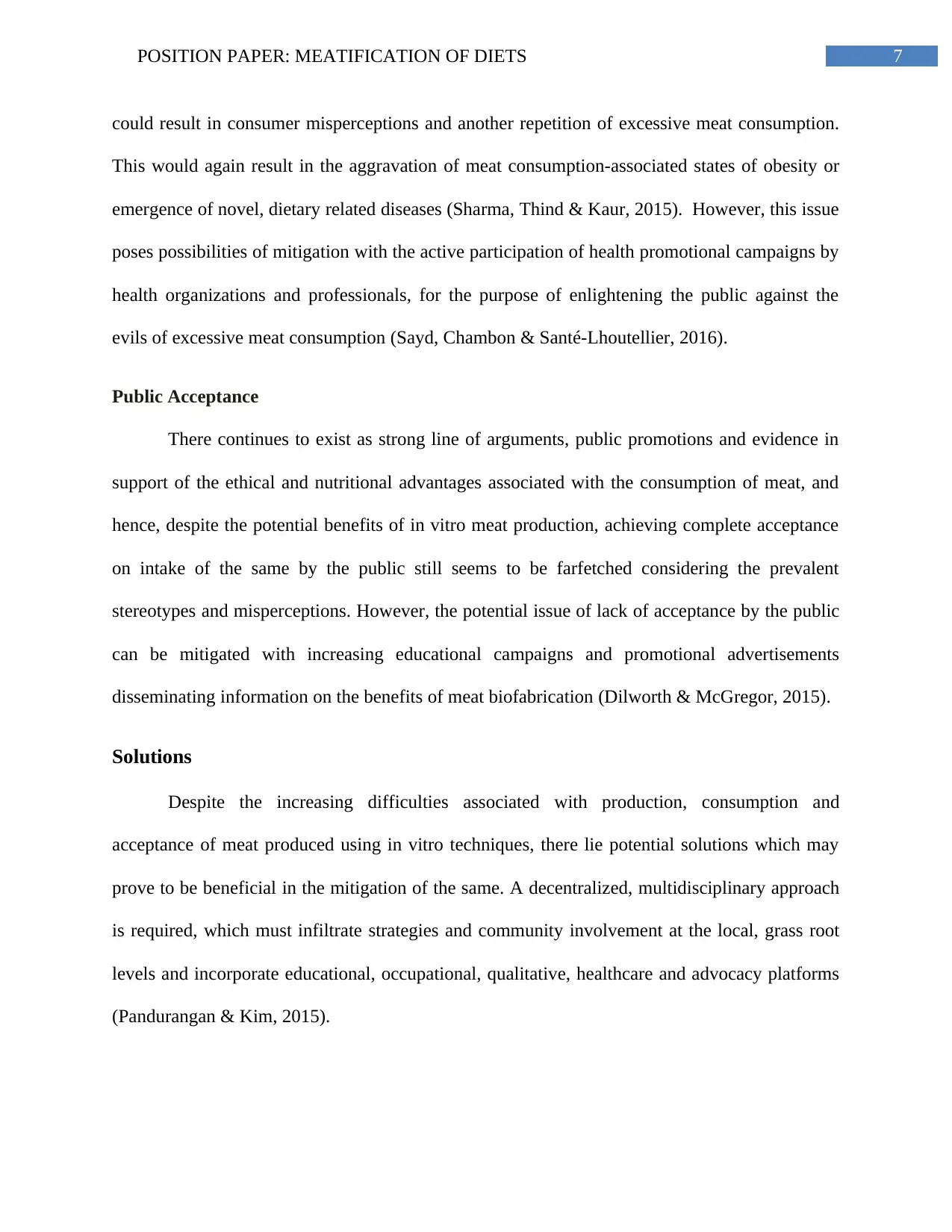
7POSITION PAPER: MEATIFICATION OF DIETS
could result in consumer misperceptions and another repetition of excessive meat consumption.
This would again result in the aggravation of meat consumption-associated states of obesity or
emergence of novel, dietary related diseases (Sharma, Thind & Kaur, 2015). However, this issue
poses possibilities of mitigation with the active participation of health promotional campaigns by
health organizations and professionals, for the purpose of enlightening the public against the
evils of excessive meat consumption (Sayd, Chambon & Santé-Lhoutellier, 2016).
Public Acceptance
There continues to exist as strong line of arguments, public promotions and evidence in
support of the ethical and nutritional advantages associated with the consumption of meat, and
hence, despite the potential benefits of in vitro meat production, achieving complete acceptance
on intake of the same by the public still seems to be farfetched considering the prevalent
stereotypes and misperceptions. However, the potential issue of lack of acceptance by the public
can be mitigated with increasing educational campaigns and promotional advertisements
disseminating information on the benefits of meat biofabrication (Dilworth & McGregor, 2015).
Solutions
Despite the increasing difficulties associated with production, consumption and
acceptance of meat produced using in vitro techniques, there lie potential solutions which may
prove to be beneficial in the mitigation of the same. A decentralized, multidisciplinary approach
is required, which must infiltrate strategies and community involvement at the local, grass root
levels and incorporate educational, occupational, qualitative, healthcare and advocacy platforms
(Pandurangan & Kim, 2015).
could result in consumer misperceptions and another repetition of excessive meat consumption.
This would again result in the aggravation of meat consumption-associated states of obesity or
emergence of novel, dietary related diseases (Sharma, Thind & Kaur, 2015). However, this issue
poses possibilities of mitigation with the active participation of health promotional campaigns by
health organizations and professionals, for the purpose of enlightening the public against the
evils of excessive meat consumption (Sayd, Chambon & Santé-Lhoutellier, 2016).
Public Acceptance
There continues to exist as strong line of arguments, public promotions and evidence in
support of the ethical and nutritional advantages associated with the consumption of meat, and
hence, despite the potential benefits of in vitro meat production, achieving complete acceptance
on intake of the same by the public still seems to be farfetched considering the prevalent
stereotypes and misperceptions. However, the potential issue of lack of acceptance by the public
can be mitigated with increasing educational campaigns and promotional advertisements
disseminating information on the benefits of meat biofabrication (Dilworth & McGregor, 2015).
Solutions
Despite the increasing difficulties associated with production, consumption and
acceptance of meat produced using in vitro techniques, there lie potential solutions which may
prove to be beneficial in the mitigation of the same. A decentralized, multidisciplinary approach
is required, which must infiltrate strategies and community involvement at the local, grass root
levels and incorporate educational, occupational, qualitative, healthcare and advocacy platforms
(Pandurangan & Kim, 2015).
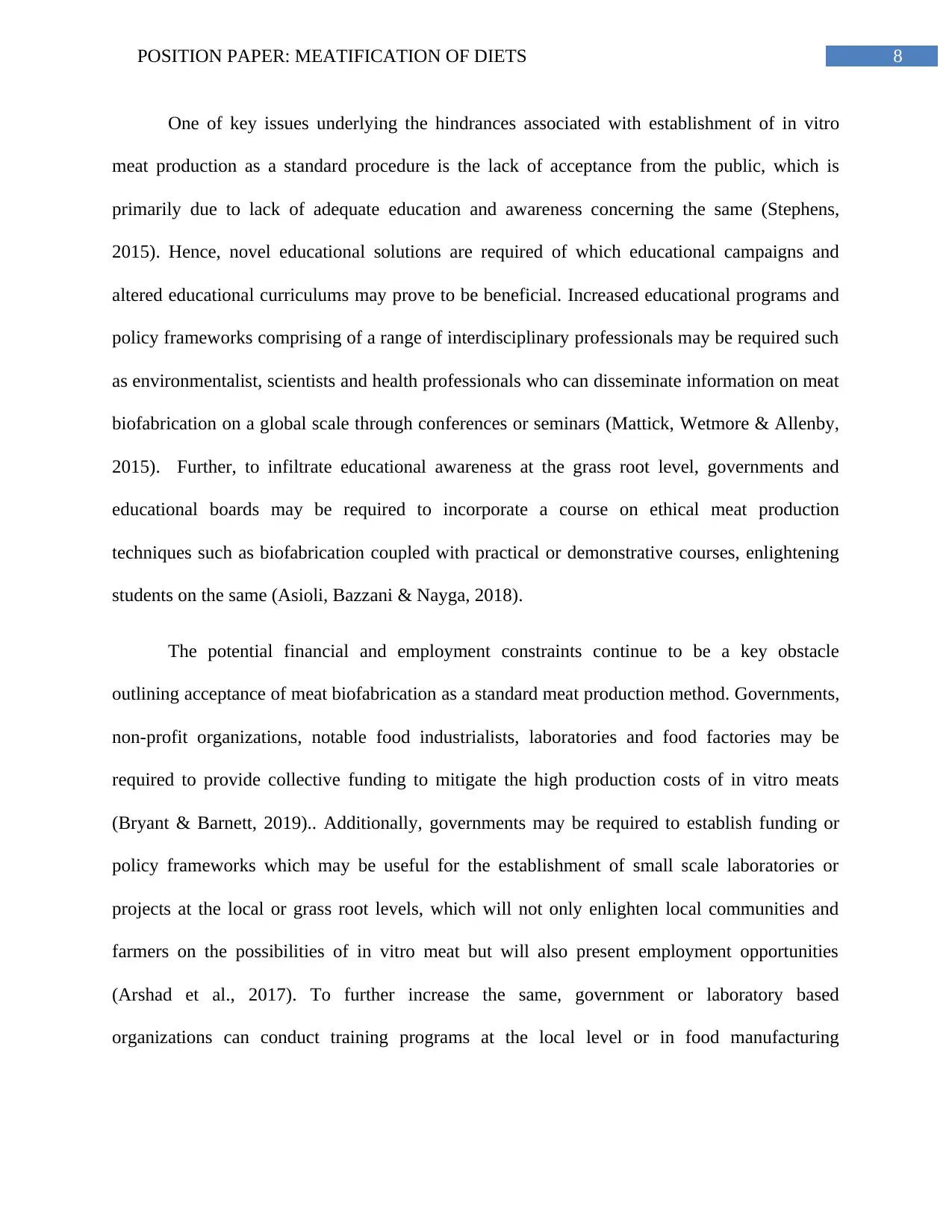
8POSITION PAPER: MEATIFICATION OF DIETS
One of key issues underlying the hindrances associated with establishment of in vitro
meat production as a standard procedure is the lack of acceptance from the public, which is
primarily due to lack of adequate education and awareness concerning the same (Stephens,
2015). Hence, novel educational solutions are required of which educational campaigns and
altered educational curriculums may prove to be beneficial. Increased educational programs and
policy frameworks comprising of a range of interdisciplinary professionals may be required such
as environmentalist, scientists and health professionals who can disseminate information on meat
biofabrication on a global scale through conferences or seminars (Mattick, Wetmore & Allenby,
2015). Further, to infiltrate educational awareness at the grass root level, governments and
educational boards may be required to incorporate a course on ethical meat production
techniques such as biofabrication coupled with practical or demonstrative courses, enlightening
students on the same (Asioli, Bazzani & Nayga, 2018).
The potential financial and employment constraints continue to be a key obstacle
outlining acceptance of meat biofabrication as a standard meat production method. Governments,
non-profit organizations, notable food industrialists, laboratories and food factories may be
required to provide collective funding to mitigate the high production costs of in vitro meats
(Bryant & Barnett, 2019).. Additionally, governments may be required to establish funding or
policy frameworks which may be useful for the establishment of small scale laboratories or
projects at the local or grass root levels, which will not only enlighten local communities and
farmers on the possibilities of in vitro meat but will also present employment opportunities
(Arshad et al., 2017). To further increase the same, government or laboratory based
organizations can conduct training programs at the local level or in food manufacturing
One of key issues underlying the hindrances associated with establishment of in vitro
meat production as a standard procedure is the lack of acceptance from the public, which is
primarily due to lack of adequate education and awareness concerning the same (Stephens,
2015). Hence, novel educational solutions are required of which educational campaigns and
altered educational curriculums may prove to be beneficial. Increased educational programs and
policy frameworks comprising of a range of interdisciplinary professionals may be required such
as environmentalist, scientists and health professionals who can disseminate information on meat
biofabrication on a global scale through conferences or seminars (Mattick, Wetmore & Allenby,
2015). Further, to infiltrate educational awareness at the grass root level, governments and
educational boards may be required to incorporate a course on ethical meat production
techniques such as biofabrication coupled with practical or demonstrative courses, enlightening
students on the same (Asioli, Bazzani & Nayga, 2018).
The potential financial and employment constraints continue to be a key obstacle
outlining acceptance of meat biofabrication as a standard meat production method. Governments,
non-profit organizations, notable food industrialists, laboratories and food factories may be
required to provide collective funding to mitigate the high production costs of in vitro meats
(Bryant & Barnett, 2019).. Additionally, governments may be required to establish funding or
policy frameworks which may be useful for the establishment of small scale laboratories or
projects at the local or grass root levels, which will not only enlighten local communities and
farmers on the possibilities of in vitro meat but will also present employment opportunities
(Arshad et al., 2017). To further increase the same, government or laboratory based
organizations can conduct training programs at the local level or in food manufacturing

9POSITION PAPER: MEATIFICATION OF DIETS
companies, which will increase the competency levels and opportunities of potential employees
(Bhat, Kumar & Bhat, 2017).
Lastly, as researched by Porier (2017), meat consumption continues to remain a
controversial issue considering its potential health implications and nutritional consequences,
which may not spare in vitro meat production. Hence the need of the hour is for the
establishment and working of scientific advisory panels consisting of health professionals,
nutritionist and quality monitoring professionals who will not only enlighten consumers on
dietary precautions but will also dictate standards on the production of nutritious in vitro meat
for concerned manufacturers and laboratories (Dagevos, 2016). Likewise, the government and
international food regulatory organizations such as the Food and Agricultural Organization
(FAO) may be required to establish a separate quality framework on in vitro meat production
similar to Hazard Analysis Critical Control Procedures (HACCP), Standard Operating
Procedures (SOP) and Good Manufacturing Practices (GMP) (Laestadius, 2015).
Conclusion
Hence, it can be concluded that, meat biofabrication can prove to be a successful
alternative in the production of meat and meat products with long term benefits. Meat
biofabrication encompasses the production of meat which is ethically acceptable, conserves
environmental resources, meets world food intake needs and prevents possible health
complications associated with conventional meat production. In order to combat issues
associated with employment losses, dietary repercussions and financial constraints a
decentralized, multidisciplinary approach may be required. Hence, with an extensive discussion
companies, which will increase the competency levels and opportunities of potential employees
(Bhat, Kumar & Bhat, 2017).
Lastly, as researched by Porier (2017), meat consumption continues to remain a
controversial issue considering its potential health implications and nutritional consequences,
which may not spare in vitro meat production. Hence the need of the hour is for the
establishment and working of scientific advisory panels consisting of health professionals,
nutritionist and quality monitoring professionals who will not only enlighten consumers on
dietary precautions but will also dictate standards on the production of nutritious in vitro meat
for concerned manufacturers and laboratories (Dagevos, 2016). Likewise, the government and
international food regulatory organizations such as the Food and Agricultural Organization
(FAO) may be required to establish a separate quality framework on in vitro meat production
similar to Hazard Analysis Critical Control Procedures (HACCP), Standard Operating
Procedures (SOP) and Good Manufacturing Practices (GMP) (Laestadius, 2015).
Conclusion
Hence, it can be concluded that, meat biofabrication can prove to be a successful
alternative in the production of meat and meat products with long term benefits. Meat
biofabrication encompasses the production of meat which is ethically acceptable, conserves
environmental resources, meets world food intake needs and prevents possible health
complications associated with conventional meat production. In order to combat issues
associated with employment losses, dietary repercussions and financial constraints a
decentralized, multidisciplinary approach may be required. Hence, with an extensive discussion
Secure Best Marks with AI Grader
Need help grading? Try our AI Grader for instant feedback on your assignments.

10POSITION PAPER: MEATIFICATION OF DIETS
on notable arguments and solutions, this paper has successfully postulated in support of the
advantages of meat biofabrication in mitigating the effects of increased dietary meatification.
on notable arguments and solutions, this paper has successfully postulated in support of the
advantages of meat biofabrication in mitigating the effects of increased dietary meatification.
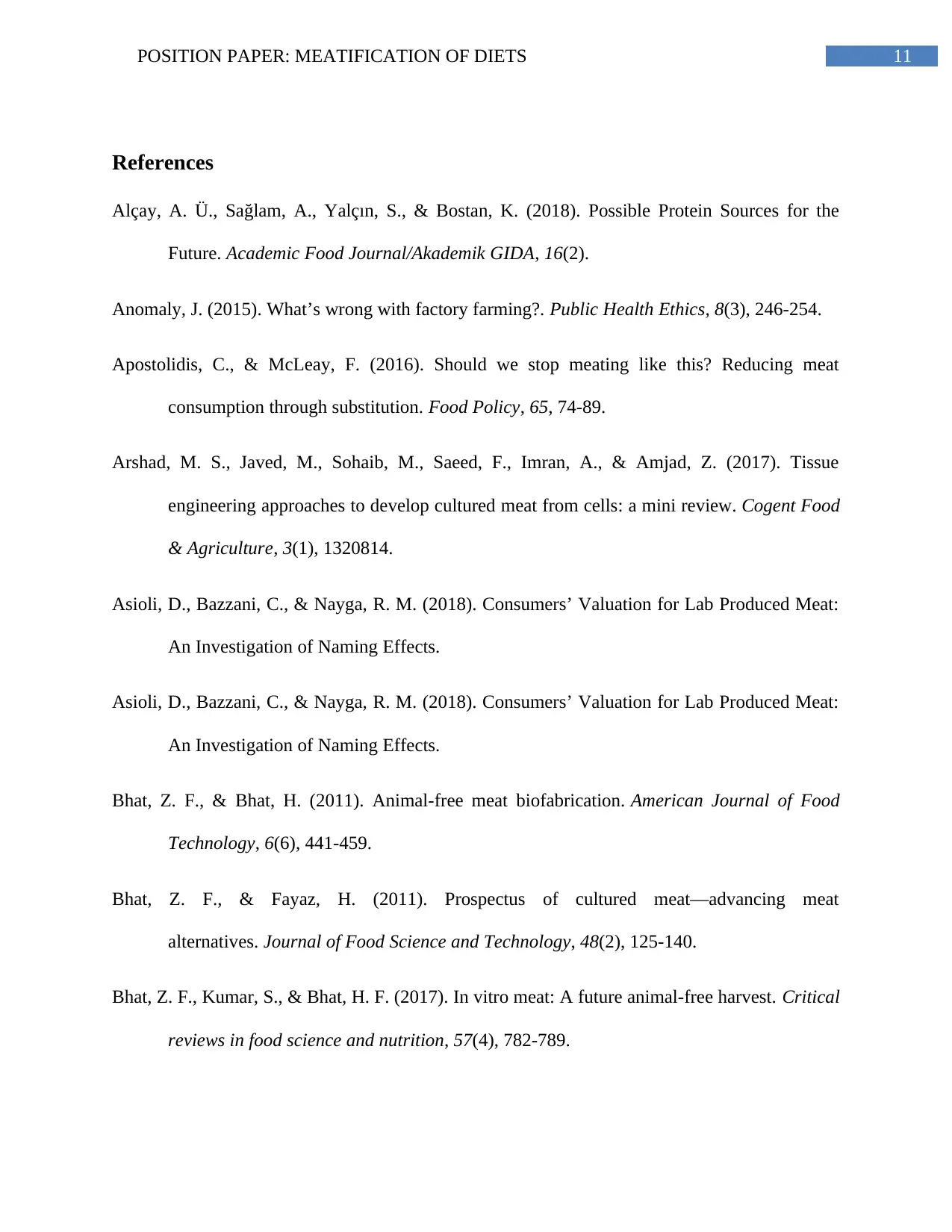
11POSITION PAPER: MEATIFICATION OF DIETS
References
Alçay, A. Ü., Sağlam, A., Yalçın, S., & Bostan, K. (2018). Possible Protein Sources for the
Future. Academic Food Journal/Akademik GIDA, 16(2).
Anomaly, J. (2015). What’s wrong with factory farming?. Public Health Ethics, 8(3), 246-254.
Apostolidis, C., & McLeay, F. (2016). Should we stop meating like this? Reducing meat
consumption through substitution. Food Policy, 65, 74-89.
Arshad, M. S., Javed, M., Sohaib, M., Saeed, F., Imran, A., & Amjad, Z. (2017). Tissue
engineering approaches to develop cultured meat from cells: a mini review. Cogent Food
& Agriculture, 3(1), 1320814.
Asioli, D., Bazzani, C., & Nayga, R. M. (2018). Consumers’ Valuation for Lab Produced Meat:
An Investigation of Naming Effects.
Asioli, D., Bazzani, C., & Nayga, R. M. (2018). Consumers’ Valuation for Lab Produced Meat:
An Investigation of Naming Effects.
Bhat, Z. F., & Bhat, H. (2011). Animal-free meat biofabrication. American Journal of Food
Technology, 6(6), 441-459.
Bhat, Z. F., & Fayaz, H. (2011). Prospectus of cultured meat—advancing meat
alternatives. Journal of Food Science and Technology, 48(2), 125-140.
Bhat, Z. F., Kumar, S., & Bhat, H. F. (2017). In vitro meat: A future animal-free harvest. Critical
reviews in food science and nutrition, 57(4), 782-789.
References
Alçay, A. Ü., Sağlam, A., Yalçın, S., & Bostan, K. (2018). Possible Protein Sources for the
Future. Academic Food Journal/Akademik GIDA, 16(2).
Anomaly, J. (2015). What’s wrong with factory farming?. Public Health Ethics, 8(3), 246-254.
Apostolidis, C., & McLeay, F. (2016). Should we stop meating like this? Reducing meat
consumption through substitution. Food Policy, 65, 74-89.
Arshad, M. S., Javed, M., Sohaib, M., Saeed, F., Imran, A., & Amjad, Z. (2017). Tissue
engineering approaches to develop cultured meat from cells: a mini review. Cogent Food
& Agriculture, 3(1), 1320814.
Asioli, D., Bazzani, C., & Nayga, R. M. (2018). Consumers’ Valuation for Lab Produced Meat:
An Investigation of Naming Effects.
Asioli, D., Bazzani, C., & Nayga, R. M. (2018). Consumers’ Valuation for Lab Produced Meat:
An Investigation of Naming Effects.
Bhat, Z. F., & Bhat, H. (2011). Animal-free meat biofabrication. American Journal of Food
Technology, 6(6), 441-459.
Bhat, Z. F., & Fayaz, H. (2011). Prospectus of cultured meat—advancing meat
alternatives. Journal of Food Science and Technology, 48(2), 125-140.
Bhat, Z. F., Kumar, S., & Bhat, H. F. (2017). In vitro meat: A future animal-free harvest. Critical
reviews in food science and nutrition, 57(4), 782-789.
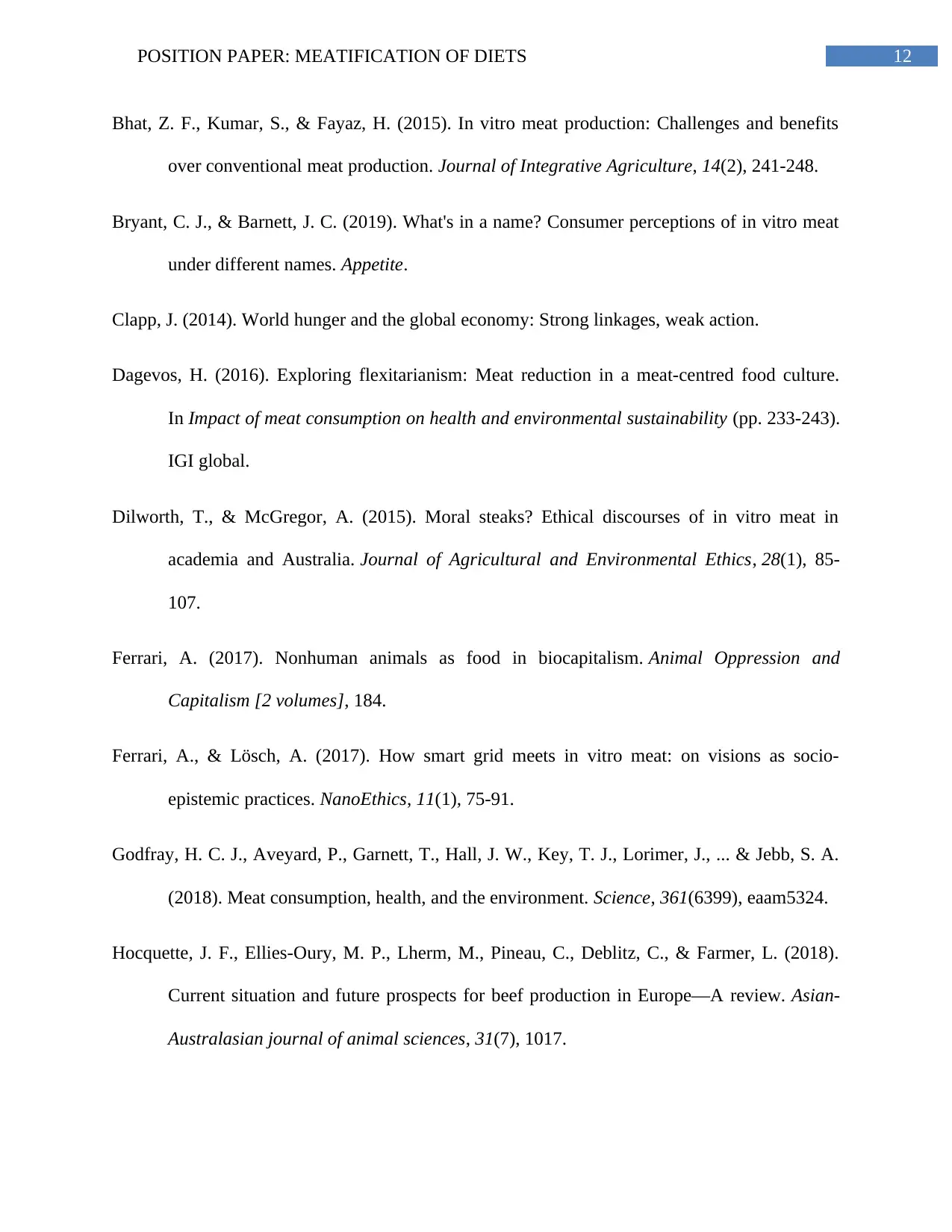
12POSITION PAPER: MEATIFICATION OF DIETS
Bhat, Z. F., Kumar, S., & Fayaz, H. (2015). In vitro meat production: Challenges and benefits
over conventional meat production. Journal of Integrative Agriculture, 14(2), 241-248.
Bryant, C. J., & Barnett, J. C. (2019). What's in a name? Consumer perceptions of in vitro meat
under different names. Appetite.
Clapp, J. (2014). World hunger and the global economy: Strong linkages, weak action.
Dagevos, H. (2016). Exploring flexitarianism: Meat reduction in a meat-centred food culture.
In Impact of meat consumption on health and environmental sustainability (pp. 233-243).
IGI global.
Dilworth, T., & McGregor, A. (2015). Moral steaks? Ethical discourses of in vitro meat in
academia and Australia. Journal of Agricultural and Environmental Ethics, 28(1), 85-
107.
Ferrari, A. (2017). Nonhuman animals as food in biocapitalism. Animal Oppression and
Capitalism [2 volumes], 184.
Ferrari, A., & Lösch, A. (2017). How smart grid meets in vitro meat: on visions as socio-
epistemic practices. NanoEthics, 11(1), 75-91.
Godfray, H. C. J., Aveyard, P., Garnett, T., Hall, J. W., Key, T. J., Lorimer, J., ... & Jebb, S. A.
(2018). Meat consumption, health, and the environment. Science, 361(6399), eaam5324.
Hocquette, J. F., Ellies-Oury, M. P., Lherm, M., Pineau, C., Deblitz, C., & Farmer, L. (2018).
Current situation and future prospects for beef production in Europe—A review. Asian-
Australasian journal of animal sciences, 31(7), 1017.
Bhat, Z. F., Kumar, S., & Fayaz, H. (2015). In vitro meat production: Challenges and benefits
over conventional meat production. Journal of Integrative Agriculture, 14(2), 241-248.
Bryant, C. J., & Barnett, J. C. (2019). What's in a name? Consumer perceptions of in vitro meat
under different names. Appetite.
Clapp, J. (2014). World hunger and the global economy: Strong linkages, weak action.
Dagevos, H. (2016). Exploring flexitarianism: Meat reduction in a meat-centred food culture.
In Impact of meat consumption on health and environmental sustainability (pp. 233-243).
IGI global.
Dilworth, T., & McGregor, A. (2015). Moral steaks? Ethical discourses of in vitro meat in
academia and Australia. Journal of Agricultural and Environmental Ethics, 28(1), 85-
107.
Ferrari, A. (2017). Nonhuman animals as food in biocapitalism. Animal Oppression and
Capitalism [2 volumes], 184.
Ferrari, A., & Lösch, A. (2017). How smart grid meets in vitro meat: on visions as socio-
epistemic practices. NanoEthics, 11(1), 75-91.
Godfray, H. C. J., Aveyard, P., Garnett, T., Hall, J. W., Key, T. J., Lorimer, J., ... & Jebb, S. A.
(2018). Meat consumption, health, and the environment. Science, 361(6399), eaam5324.
Hocquette, J. F., Ellies-Oury, M. P., Lherm, M., Pineau, C., Deblitz, C., & Farmer, L. (2018).
Current situation and future prospects for beef production in Europe—A review. Asian-
Australasian journal of animal sciences, 31(7), 1017.
Paraphrase This Document
Need a fresh take? Get an instant paraphrase of this document with our AI Paraphraser
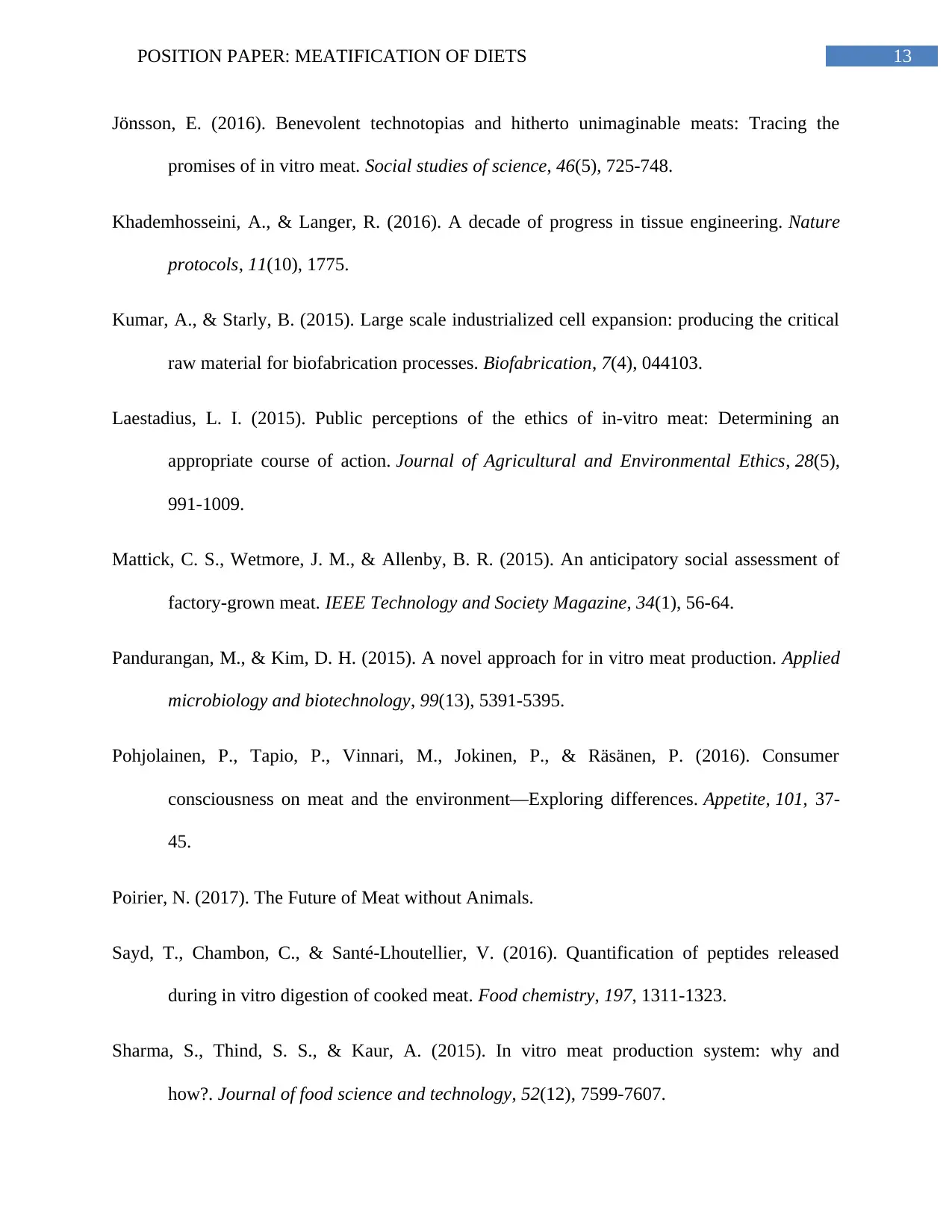
13POSITION PAPER: MEATIFICATION OF DIETS
Jönsson, E. (2016). Benevolent technotopias and hitherto unimaginable meats: Tracing the
promises of in vitro meat. Social studies of science, 46(5), 725-748.
Khademhosseini, A., & Langer, R. (2016). A decade of progress in tissue engineering. Nature
protocols, 11(10), 1775.
Kumar, A., & Starly, B. (2015). Large scale industrialized cell expansion: producing the critical
raw material for biofabrication processes. Biofabrication, 7(4), 044103.
Laestadius, L. I. (2015). Public perceptions of the ethics of in-vitro meat: Determining an
appropriate course of action. Journal of Agricultural and Environmental Ethics, 28(5),
991-1009.
Mattick, C. S., Wetmore, J. M., & Allenby, B. R. (2015). An anticipatory social assessment of
factory-grown meat. IEEE Technology and Society Magazine, 34(1), 56-64.
Pandurangan, M., & Kim, D. H. (2015). A novel approach for in vitro meat production. Applied
microbiology and biotechnology, 99(13), 5391-5395.
Pohjolainen, P., Tapio, P., Vinnari, M., Jokinen, P., & Räsänen, P. (2016). Consumer
consciousness on meat and the environment—Exploring differences. Appetite, 101, 37-
45.
Poirier, N. (2017). The Future of Meat without Animals.
Sayd, T., Chambon, C., & Santé-Lhoutellier, V. (2016). Quantification of peptides released
during in vitro digestion of cooked meat. Food chemistry, 197, 1311-1323.
Sharma, S., Thind, S. S., & Kaur, A. (2015). In vitro meat production system: why and
how?. Journal of food science and technology, 52(12), 7599-7607.
Jönsson, E. (2016). Benevolent technotopias and hitherto unimaginable meats: Tracing the
promises of in vitro meat. Social studies of science, 46(5), 725-748.
Khademhosseini, A., & Langer, R. (2016). A decade of progress in tissue engineering. Nature
protocols, 11(10), 1775.
Kumar, A., & Starly, B. (2015). Large scale industrialized cell expansion: producing the critical
raw material for biofabrication processes. Biofabrication, 7(4), 044103.
Laestadius, L. I. (2015). Public perceptions of the ethics of in-vitro meat: Determining an
appropriate course of action. Journal of Agricultural and Environmental Ethics, 28(5),
991-1009.
Mattick, C. S., Wetmore, J. M., & Allenby, B. R. (2015). An anticipatory social assessment of
factory-grown meat. IEEE Technology and Society Magazine, 34(1), 56-64.
Pandurangan, M., & Kim, D. H. (2015). A novel approach for in vitro meat production. Applied
microbiology and biotechnology, 99(13), 5391-5395.
Pohjolainen, P., Tapio, P., Vinnari, M., Jokinen, P., & Räsänen, P. (2016). Consumer
consciousness on meat and the environment—Exploring differences. Appetite, 101, 37-
45.
Poirier, N. (2017). The Future of Meat without Animals.
Sayd, T., Chambon, C., & Santé-Lhoutellier, V. (2016). Quantification of peptides released
during in vitro digestion of cooked meat. Food chemistry, 197, 1311-1323.
Sharma, S., Thind, S. S., & Kaur, A. (2015). In vitro meat production system: why and
how?. Journal of food science and technology, 52(12), 7599-7607.
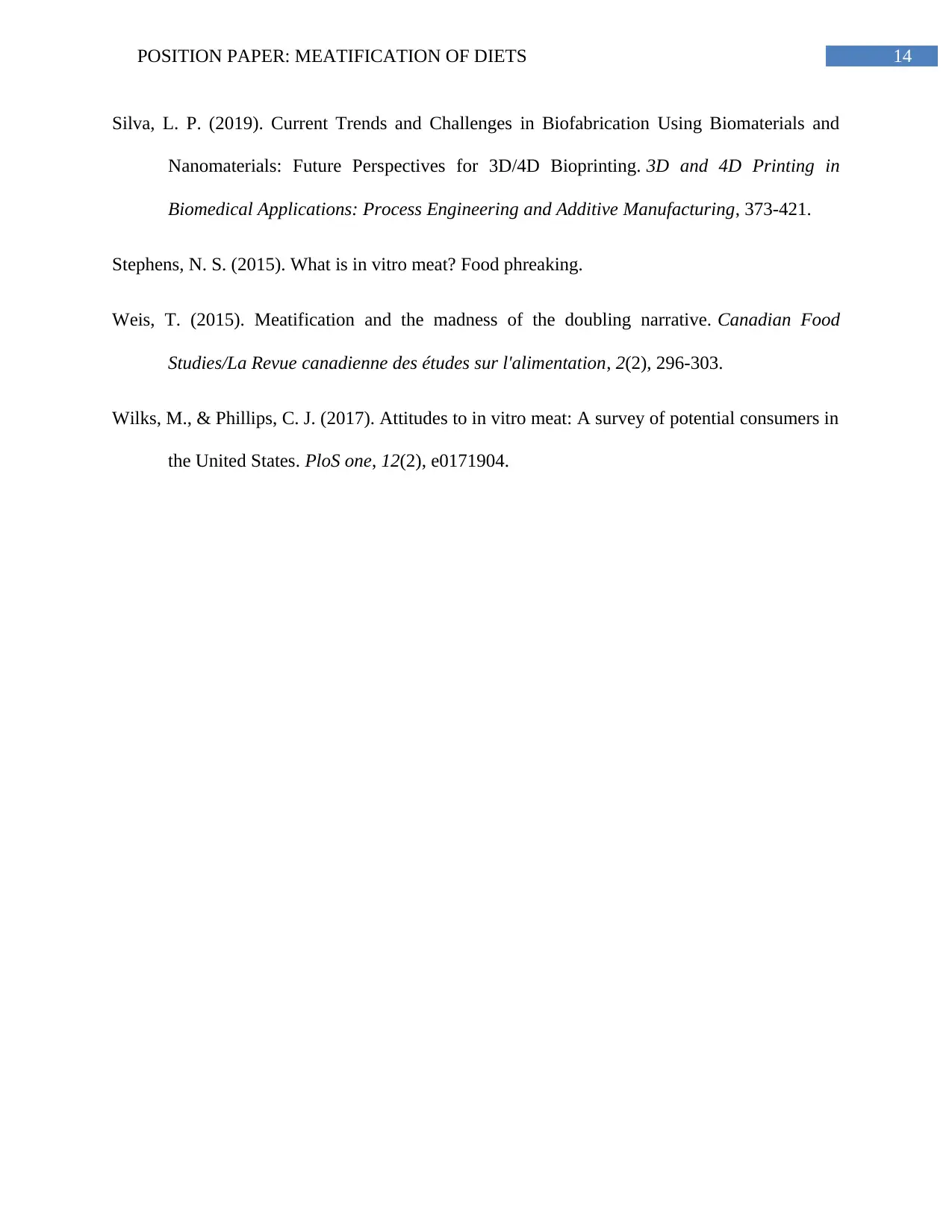
14POSITION PAPER: MEATIFICATION OF DIETS
Silva, L. P. (2019). Current Trends and Challenges in Biofabrication Using Biomaterials and
Nanomaterials: Future Perspectives for 3D/4D Bioprinting. 3D and 4D Printing in
Biomedical Applications: Process Engineering and Additive Manufacturing, 373-421.
Stephens, N. S. (2015). What is in vitro meat? Food phreaking.
Weis, T. (2015). Meatification and the madness of the doubling narrative. Canadian Food
Studies/La Revue canadienne des études sur l'alimentation, 2(2), 296-303.
Wilks, M., & Phillips, C. J. (2017). Attitudes to in vitro meat: A survey of potential consumers in
the United States. PloS one, 12(2), e0171904.
Silva, L. P. (2019). Current Trends and Challenges in Biofabrication Using Biomaterials and
Nanomaterials: Future Perspectives for 3D/4D Bioprinting. 3D and 4D Printing in
Biomedical Applications: Process Engineering and Additive Manufacturing, 373-421.
Stephens, N. S. (2015). What is in vitro meat? Food phreaking.
Weis, T. (2015). Meatification and the madness of the doubling narrative. Canadian Food
Studies/La Revue canadienne des études sur l'alimentation, 2(2), 296-303.
Wilks, M., & Phillips, C. J. (2017). Attitudes to in vitro meat: A survey of potential consumers in
the United States. PloS one, 12(2), e0171904.
1 out of 15
Your All-in-One AI-Powered Toolkit for Academic Success.
+13062052269
info@desklib.com
Available 24*7 on WhatsApp / Email
![[object Object]](/_next/static/media/star-bottom.7253800d.svg)
Unlock your academic potential
© 2024 | Zucol Services PVT LTD | All rights reserved.
